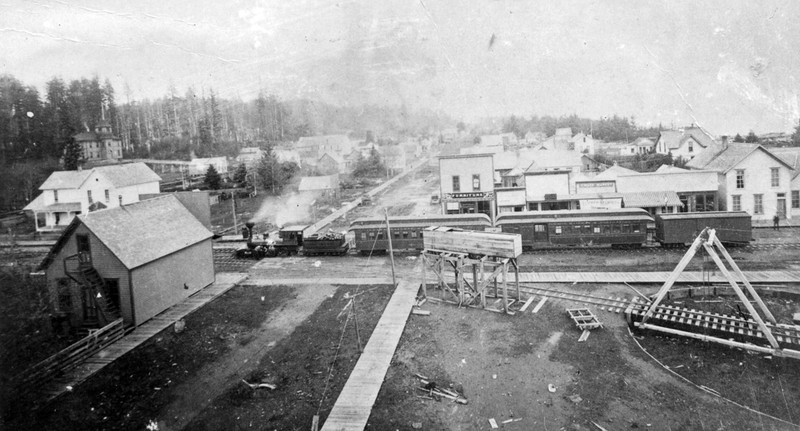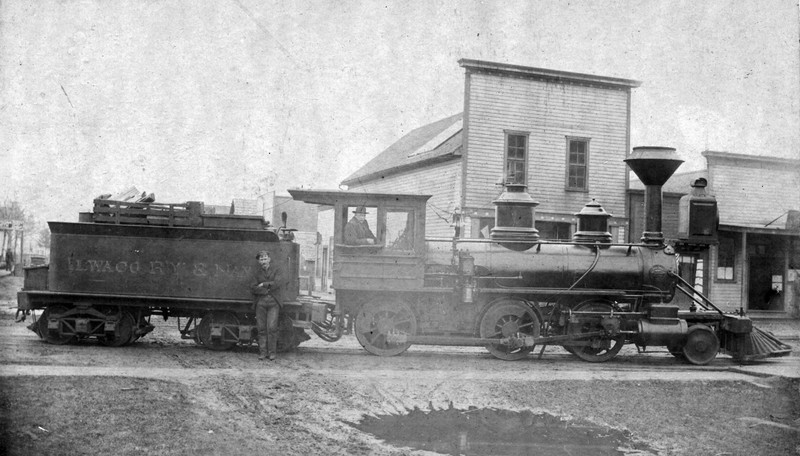IR&N Railroad Turntable 1888
Introduction
Text-to-speech Audio
The railroad turntable was located on the west side of First Street near Lake Street. The railroad line originally ran from Ilwaco to Nahcotta and had a turntable on each end. Businesses and homes were located nearby. The IR&N was an important part of the history of the peninsula and transported tourists and locals, as well as goods such as lumber and oysters. One of the original passenger cars of the IR&N, the Pullman built Railcar NAHCOTTA is located at the Columbia Pacific Heritage Museum in Ilwaco.
To view a youth created video interview with local railroad expert Mark Clemmens, click the link below under Additional Information.
Images
Turntable in Ilwaco

IR&N Co. Engine & wood car Ilwaco 1894

Backstory and Context
Text-to-speech Audio
The story of transportation on the peninsula begins with Lewis Alfred Loomis. Loomis was born in Ithaca, NY. His first trip here in 1855 was to visit his brother Edwin G. Loomis at Pacific City. Later that year, Lewis Loomis fought in the battle of Walla Walla during the Indian Wars and was a commissioned second lieutenant, Company B, 1st Regiment Oregon Volunteers. Returning to the east coast in 1857 he spent several years caring for family before going South in 1864. It was there that he had charge of a construction company building and repairing railroads for army movement during the Civil War.
Loomis returned to the Pacific Northwest in 1872, arriving in Oysterville in the spring. That same year he bought his home located at Loomis Station, south of present day Klipsan, and went into the sheep business with his brother Edwin. As Sydney Stevens writes in Legendary Locals, “An unfortunate wool-wetting experience between shore and boat convinced him to build a dock at Ilwaco.” Together with his brother and other investors, the Ilwaco Wharf Company was formed. Soon he received the mail contract between Olympia and Astoria. He bought stagecoaches to carry the mail from Oysterville to Ilwaco along the weather beach. In 1875, he and his partners formed the Ilwaco Steam Navigation Company. They purchased the General Canby to traverse the Columbia between Ilwaco and Astoria and built steamboats in South Bend to cross Shoalwater Bay at the northern end of the peninsula.
A contemporary account of Loomis’s life by his friend Isaac Whealdon states, “It is not easy to give an idea at this late date of the magnitude of L .A. Loomis' business at that time, but suffice to say he was getting rich very fast. His stage line was at that time the best paying business in our county, but there was an ever-growing demand for something better, and in the years from 1875 to 1885 we heard continuously of the contemplated building of a railroad into Pacific County. It remained for Mr. Loomis to again organize a company to build a railway and this he did, knowing very well that it would be the ruination of his private business. Mr. Loomis made this remark to the writer of this article in the summer of 1886. So in 1887 the Ilwaco Steam Navigation Company became known as the Ilwaco Railway and Navigation Company. In 1888 they had five miles of railroad in operation from the town of Ilwaco north, built the steamer General Miles, and bought the Dolphin and the Ocean Wave. This gave them in the summer season, a daily service between Astoria and Ilwaco, and thrice a week service by Ocean Wave from Portland to Ilwaco.”
By July 1888, the tracks for the Ilwaco Railroad, as it was known then, reached north from Ilwaco to Tinkerville, now known as Long Beach. The Ilwaco railroad had been built as far as Tinker’s Hotel, a distance of about five miles. The road cost about $30,000. It is estimated that the receipts of the company for the first six weeks were nearly $40,000, according to the Astoria Pioneer. The Ilwaco railroad was carrying a thousand passengers every day. The reason it wasn’t carrying more, was because there were not yet enough cars.
Work on the rest of the track to the north didn’t start until the visitors were gone for the season. It wasn’t until the following year that it was connected to the dock at Nahcotta. On July 19, a grand celebration was held to commemorate the occasion. A special train was set up to carry riders the total distance of the tracks. Four flat cars, which had been used for hauling everything from sixty-pound rails to horses and cows, were fitted with plank seats, side rails, and colorful canopies to shield riders from the sun. Locomotive #1, driven by engineer George Jennings, hauled the cars, which were filled to the last seat with riders. At each end of the line a banquet was held, complete with “the usual speeches. Some orators let their imaginations produce the railroad line following the Pacific shore from Puget Sound to San Francisco.”
By 1889 the Ilwaco Railway and Navigation Company had expanded and completed its route from Ilwaco to Nahcotta. It became a vital part of the our history as it transported tourists and locals up and down the North Beach peninsula and took our local goods (lumber, oysters, and cranberries) to market. The railway opened the way for expanded settlement of the Peninsula.
Sources
Jessett,, Thomas E. . The Ilwaco Railroad.
Oregon Historical Quarterly, vol. 58, no. 1957.
Morning Oregonian August 17, and 19,1888 ed.
CPHM Research Files
Isaac Whealdon interview, "Legendary Locals", by Sydney Stevens
CPHM Photo Collection - 1999.90.300
CPHM Photo Collection - L 2012.41.87
